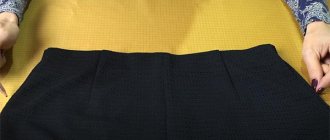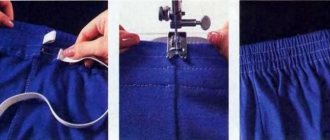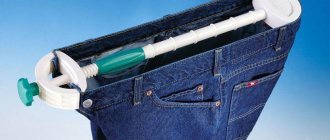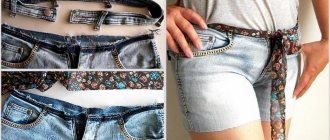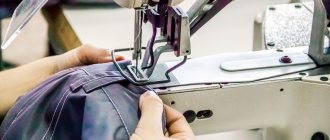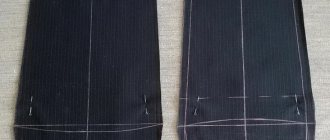It is no exaggeration to say that almost everyone has a favorite pair. The kind of pair that you think fits perfectly. Very comfortable to wear. And so on, so on, so on...
I am sure that as a result of this, that is, the ease of wearing, and the special affection for these jeans, they are worn to such an extent that they simply begin to fall apart. Of course, you can apply patches. Moreover, the Internet is full of materials on clothing repair. Jeans, due to their democratic nature, will withstand any violence against themselves with dignity. They remained quite cute.
But! There are a lot of people who like to remake things. I like to recycle things whenever possible. Therefore, who is stopping you from taking jeans that you don’t really like, for example, a little baggy, and adjusting them to your figure? Second-hand stores can be an excellent source of raw materials for alterations.
Of course, there are certain requirements for altered jeans. At a minimum, they should fit well at the waist. Be not too big and not too small. But on the hips, they can be anything. Here's the fit at the hips, we'll try to adjust it. Using your favorite jeans as a template.
And here are the instructions on how to do it.
How to properly sew jeans on the sides and legs?
If you have lost a couple of kilograms, or you are tired of the once fashionable flared trousers, you can easily sew them in your legs. After this home renovation, you will get fashionable skinny jeans. To properly sew your favorite thing on your feet, you should know certain secrets:
- Put on the jeans turned inside out and mark with pins the place for sewing - it will be at the very feet, but it is better to leave 1-2 cm for shrinkage after washing
- Take off your trousers and place them on the table, straightening them out. The trousers must lie flat so that the stitching does not distort
- Arm yourself with white soap and sharpen the edge of the product - you will use it to mark the stitching areas
- To begin with, circle the area near the pins with soap, this will make the measurements more accurate.
- In the future, you will need a thread and a needle and a sewing machine, first, baste the edges of the jeans, follow the pin as a guide - the lines should go exactly along the measurements
- Try on basted jeans, if this preliminary sewing is suitable, remove the jeans and proceed to the final
- Cut off the excess part of the jeans that extends beyond the intended area and stitch the jeans on a sewing machine
- Sew the edges using an overlocker or zigzag
When sewing jeans into the legs, the main thing is to take the correct measurements.
For the first time, the procedure may seem complicated to you, so if you have expensive jeans, you should practice on some cheaper item. But when you get good at it, carrying out such repair work will be as easy as shelling pears for you.
Method one
- First of all, you need to try on your jeans and fix the hem line at the bottom. Next, the bottom of the trousers is swept along the indicated line, the trousers are tried on again, and corrections are made if necessary.
- Then the folds of the bottom of the jeans are ironed. It is necessary to leave at least 1 cm for the hem of the bottom of the pants. Unnecessary fabric is cut off, the cut is sewn with a zigzag, manually or by machine.
- The bottom of the trousers can be hemmed by hand using blind stitches or a goat seam. You can also use adhesive tape or non-woven fabric to glue the bottom of the jeans; in this case, it is advisable to add bartacks along the side seams.
How to sew jeans in at the waist?
There is such a situation that jeans fit like a glove on the hips, but at the waist they bulge unattractively. In such a situation, you should also carry out minor repairs, which, if you have a sewing machine, can be done at home, for this:
- In the case where the extra width is no more than 2-3 cm, an elastic band can save you. Buy a wide elastic band, cut the waistband on each side of the jeans from the inside out and thread the elastic along the entire length. Carefully sew the elastic to the waistband, paying special attention to the cut areas
- If you need to suture from 3 to 7 cm, there will be more work. First, secure the waistband at the back, between the side seams.
- Wear jeans turned inside out and ask someone you know to pin up the darts that are in the back. The main thing is that they are located evenly from the seam in the middle
- Remove the jeans and carefully sew the parts that were marked
- After this, carefully iron the stitched part
- Take threads that match the color of the main ones and fix the dart on the outside, stitching along the entire length
- Next, cut the belt, this can be done by undoing the middle loop
- Attach the waistband to the jeans and measure the excess portion that needs to be cut off
- Now you need to re-sew the already cut belt
- Re-sew the waistband to the jeans and close the seam with the belt loop.
There is another way in which you can sew in jeans, but it will take you more time and effort. But the result will be very high quality. You need to do the following:
- Open the belt loop at the back and open the waistband about 10 cm on each side of the middle seam
- Open the seam that goes between the legs (it is called the step seam) by 10 cm
- Open the middle seam, but do not unroll it, as it may move. Just carefully pin it on the front side
- Go through all the seams from the inside and also secure with pins, after which all fastenings on the front side can be removed
- Steam the seams thoroughly with an iron
- Place the legs inside each other and, 2 cm away from the middle seam, draw a line to form a triangle. The drawn line should go along the waist line
- Make a stitch along the drawn line and overcast the edge
- Sew the crotch seam from the back with one line, from the front - double
- Cut the belt in half and apply it to the stitched jeans, remove excess fabric
- Sew the waistband from the right side, iron it and align it with the trousers.
- Secure with pins and stitch carefully
Important: To ensure that the elastic is the correct length, measure yourself with it around your waist and sew the elastic into your jeans 3-5 cm less. This way, by stretching, the elastic band will be the desired length.
You can sew in jeans even at home.
Thanks to this method, you can remove the excess part of jeans that stands out unattractively at the waist. The last option will look especially high quality, but if it seems too complicated to you, use the rest. If done carefully, the result will definitely be of high quality.
Method two
This method of hemming involves preserving the edge (factory processing of the bottom), it is now very popular. In this case, the hem is carefully torn off, 1 cm is set upward from the finishing line, and a cut is made along the line. The result is a detail - “bottom”.
Next, you need to try on the denim product, mark the fold, mark the seam allowance up, and cut off the excess. As a result, for each pant leg there are jeans themselves and a hem. They need to be folded in pairs with the front sides inward, carefully aligning the step and side cuts. Then everything should be pinned together and stitches should be laid around the pant leg. The seam must be ironed. The finishing stitch should then be placed into the split seam.
How to sew jeans a size smaller?
Losing those extra pounds certainly lifts your spirits, but it also causes wardrobe malfunctions. If your jeans have become too big for you, then this can be corrected, especially if the reduction is only one size:
- The easiest way is washing. Set the washing machine to 95C and put the jeans in a hot wash. This process should be repeated twice, and make sure that cold water does not penetrate the jeans.
- When setting the machine to the cold rinse mode, stop the process. Dry washed trousers on a hot radiator or using a steam dryer. This method is quite good, but after a certain time the jeans may stretch again, so you will have to repeat the procedure again
- Another method is suturing. If your jeans are too big at the waist and hips, sew them in at the side. To do this, turn the jeans inside out and mark with a pin the places that need to be cut.
- Walk along the jeans with soap, break off the pins and mark the places for the new stitching with thread. Put the jeans back on and if they now fit well, trim off the excess fabric and stitch the pants
- If the jeans are just right in the hips and there is a lot of excess fabric in the waist, it’s not a problem, sew in the pants along the seam that is located at the back. Open the belt loop and cut the belt in the middle
- You need to make darts on each side - there you will hide excess material. Do not make very long darts, as this may cause unsightly folds on the back pocket.
- When you have removed everything unnecessary, sew the belt to the jeans and return the belt loop
- A very simple way is to sew jeans using the side seams. In these places you need to make darts; to do this, open the stitching that runs along the side seams
- Next, carefully place the excess fabric under the side seams and stitch the jeans together again. This option is suitable if you have a high-quality machine or thin jeans, since the side seams are quite tight
You can easily sew in jeans at home
If your jeans are a size too big, it is very easy to adjust them to fit you thanks to these methods. Don't forget about your favorite thing, everything can be fixed. Even if the trousers are too big in one particular place, you can pay attention and correct this particular part of the jeans. You should not contact workshops - you will spend a decent amount there. At home, if you follow these recommendations, you will carry out repair work like a real seamstress. Moreover, you are doing this kind of work for yourself, which means you will definitely do everything carefully and conscientiously.
Useful tips
To properly sew jeans along the inside or outside side seam, you should follow some recommendations:
- It is best to mark new side seams with chalk or soap, since these components are easily removed from the material by regular steaming.
- It is recommended to use white thread to mark the new side seam as it does not contain any dye and will stand out clearly on the jeans so it is easy to remove.
- At the end of the procedure, the product should be ironed so that the side seams and fabric unevenness are evened out.
- Not every home sewing machine is capable of sewing denim, so if the fabric is dense, you should contact a studio.
We recommend reading: Why there is condensation in the toilet: reasons why it’s wet outside, what to do to stop sweating
Recommendations for sewing jeans
If you don’t want to go to a tailor, you can easily alter your jeans yourself. Useful lifehacks will help you do everything right:
- Be sure to iron the seams as you work. Do the same after completion to return the trousers to their original appearance and smooth out any protruding seams.
- Work with pants that are clean but already worn. This way you will understand how much jeans can stretch. But keep in mind that the product will shrink after washing.
- Don't neglect finishing the edges. This will prevent the fabric from fraying and extend the life of the item.
- Don't do the job hastily. Each sub-item must be included (measurements, basting, etc.). This will help avoid damage to the product.
- Don't strip off excess. Not everyone can fully sew an item.
- Select threads carefully based on color and strength. For denim, it is advisable to buy special ones - they are reliable.
- Be sure to remove old threads from the fabric, otherwise they will ruin the look.
- If you don’t want to waste time on long fittings, then use the method of using a second product that fits your figure perfectly. If you have such jeans in stock, then you just need to remove the pattern from it and transfer it to a wide model. Another option is to attach the item to the pants being altered and make notes.
Original solutions and improvised means
The previous method is quite effective, but it’s still better to take care of your own body. A simple solution: instead of your legs, squeeze some kind of “substitute” into your damp jeans. For example, a tightly rolled pillow or sofa cushion. This will definitely help if the item is narrow in the hips or calves.
In the case of a tight belt, it is best to choose an ordinary wooden stick or a piece of a narrow board. Its length should be equal to the half-circumference of your waist plus one and a half to two centimeters. Having pulled wet jeans onto this support, you should leave the product alone until it dries completely.
Some brave people use special products to expand shoes - they are applied to problem areas instead of water, and then put on jeans. There will be an effect, but not necessarily only the one we wanted to expect. This barbaric method can ruin an expensive item, but what’s even more dangerous is damaging the skin, causing an allergic reaction.
Model preparation
Before you start sewing jeans, you need to prepare the model for work. Pants can be hemmed not only from the bottom, but also in other places where it is necessary. If the goal is to narrow the item at the bottom, then the product is turned inside out and the bottom seams are ripped out, which are then ironed well.
It is worth noting that both women's and men's pants are sewn according to the same principle. The final result will depend only on the preferences of the person himself.
Preparation for sewing at the hips consists of cutting the side seams (which are located higher), and to reduce the waist, the item is unzipped from the back. When ironing, special attention should be paid to the seams, so that later it will be easier to work with them. When cutting, it is important to be careful not to cut off too much or make a crooked line.
The following tips may be helpful when sewing:
Features of work
Working with denim requires knowing some secrets and nuances.
You need to know how to work with denim
We are talking primarily about the following points:
- Before cutting, the jeans product must be washed. Washing will soften the fabric and make it much easier to work with.
- Scissors should only be used that are well sharpened. And you need to be prepared for the fact that after cutting they will most likely become dull.
- You need to install special thick needles in your sewing machine that will not become dull or break.
- It is recommended to use heavy-duty threads. If you can’t find special threads for denim, you can replace them with polyester or durable cotton ones.
- On particularly thick areas, do not sew using the machine pedal. It will be easier and safer to stitch such thickened areas by slowly turning the wheel by hand.
- Seam allowances must be ironed.
- It will be easier to sew jeans with a stitch with an increased length.
Properly fitted jeans are comfortable to wear
Sewing jeans, although not the most difficult process, does require certain skills. If someone has minimal or no sewing experience, it is strongly recommended not to experiment. It would be much more prudent to seek help from specialists who will quickly and efficiently adjust any item of denim clothing to the desired size.

